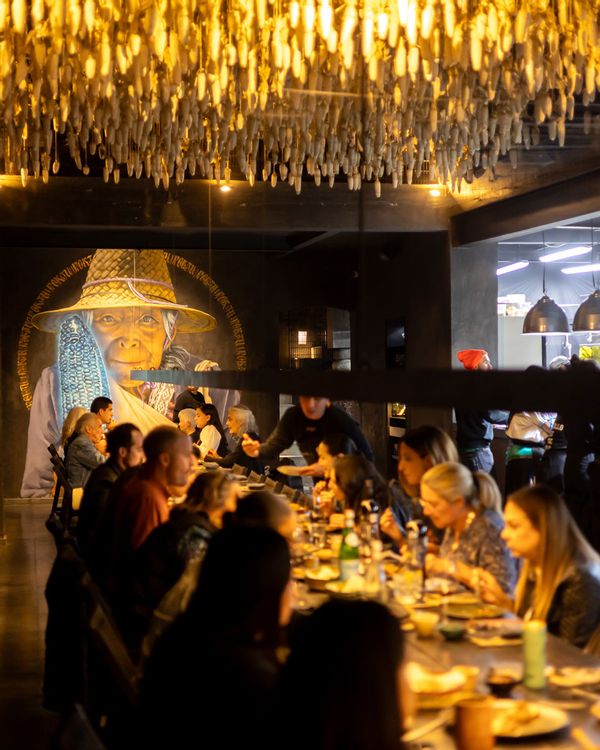
It seems like everybody is making their way to Mexico City to see for themselves how good the madre mole at Pujol is, if the tuna tostadas and carajillos at Contramar are worth the hype and whether the drinks at Tlecān are really the best in the world.
Mexico City or la ciudad, “the city,” as it’s known colloquially, earned its moment. It’s worth the trip for the food alone (the amount of history and culture is another trip unto itself), but those in the know are spending their time elsewhere: a 90 minute flight west, in Guadalajara — Mexico’s second largest city and burgeoning playground of gastronomy, art and culture.
Nestled within the heart of the city in the Santa Teresita neighborhood is a black wall with thin, minuscule letters spelling out “Xokol,” the Náhuatl word describing colored corn. It’s not quite the seamless solidness of the wall Jennifer Connelly’s character encountered in the “Labyrinth,” but it does have a similar quality. Because once you move into the depths of the barrier and wind through a short tunnel entrance, you’re immediately transported into a room that feels more ceremonial than one solely made for dining.
The transition from the outside world to this interior is striking. Everything goes from technicolor to a muted black, where only occasional bursts of yellow light punctuate the darkness to showcase the room’s focal points. A long oak table stretches the length of the room, unbroken and capable of seating up to 50 guests. Above, a large skylight is adorned with hundreds of suspended corn cobs, their illuminated forms offering one of the few sources of light in the dark and moody, monochromatic space. The bright light from the kitchen and a collection of backlit jars filled with corn kernels — evoking feelings of a science laboratory — also draw your eye. The scent of copal, a tree resin used by Mesoamerican cultures for spiritual, medicinal and practical rituals, wafts through the space.
There are no tacos or burritos on the menu. Those would be considered too modern by Chefs Xrysw Ruelas and Óscar Segundo, the wife-and-husband duo behind the restaurant, in light of their mission — preserving their ancestral culture.

She began her culinary career looking outward, following the trend of prioritizing French and Japanese cooking techniques, until it became clear that there was work to do at home. “I saw Mexican customers who wouldn’t eat blue masa tortillas,” remembers Ruelas. “They perceived the color variation as being of inferior quality to the white masa tortillas despite the blue masa having higher health benefits.”
Segundo, Ruelas’ husband, identifies as Mazahua, an indigenous population located in the state of Mexico. Together, they began considering ways to preserve culture through pre-Colombian food ingredients and centuries-old cooking techniques.
The couple wears their hearts on their sleeves. The only pinned video on their Instagram account of nearly 100,000 followers features Juana Segundo Casimiro and Juana Segundo Alcántar, Chef Segundo’s respective mother and grandmother. The video begins with the text cocinar es un acto de amor, “cooking is a labor of love,” before turning things over to Juana Segundo Casimiro to explain the history and preparation of sendecho, a fermented beverage made from heirloom corn used by the Mazahua in ceremony.

That kind of ancestral knowledge is what they’re bringing to dishes such as pescado con leche de tigre de espirulina, a Peruvian citrus-based ceviche made electric blue thanks to the blue-green algae spirulina (considered “food of the Gods” by the Aztecs); a taco ceremonial mazahua, a tortilla stamped with various designs using an carminic acid ink produced by insects living on cactus paddles; an uchepo, a sweet, tamal associated with the indigenous Purepecha people of Michoacan, Mexico.
For the couple, the work is personal. They’re not just highlighting or preserving pre-Colombian culture, they’re keeping their family history alive and giving their indigenous heritage the respect it deserves for knowledge helmed over centuries in a way not often seen in fine dining. Juana Segundo Alcántar, Chef Segundo’s grandmother, looks over the dining room where icons such as Enrique Olivera of Pujol and Patti Smith have come to see what the hype is about. The matriarch of the family is immortalized on the back wall of the dining room, holding up an ear of blue corn almost as an invitation to anyone who looks into her eyes, to see what she sees.
“No es negocio es para alimentarse“ — It’s not business, it’s to nourish people — Ruelas confirms, in case there were any doubts.






